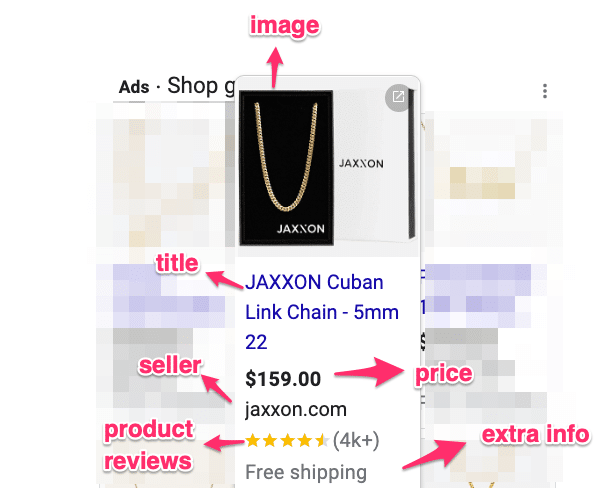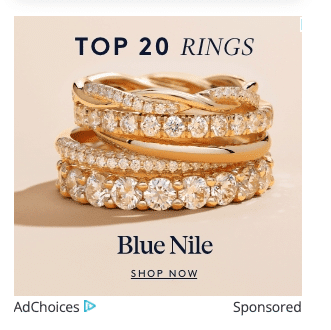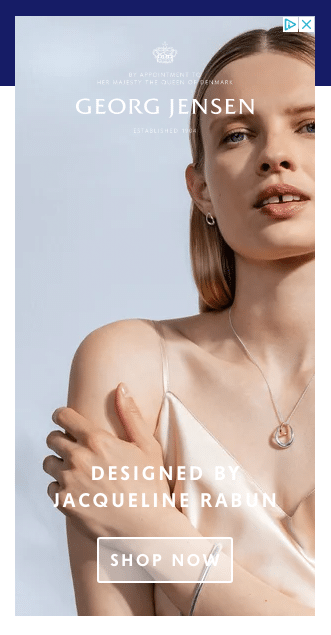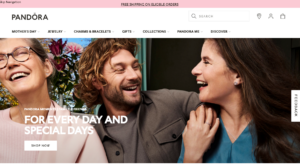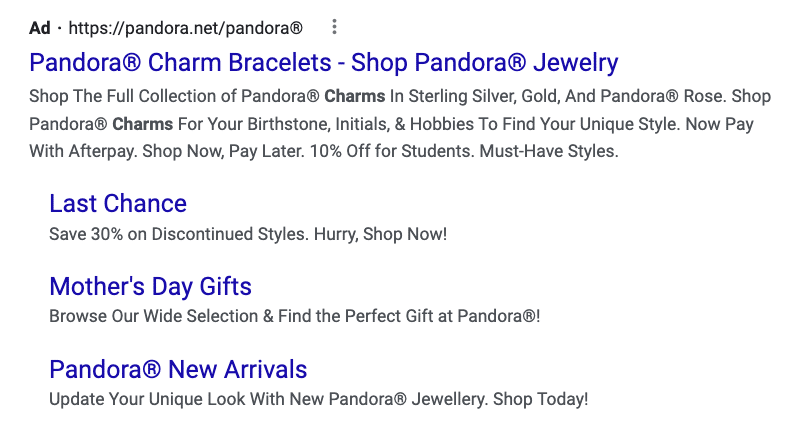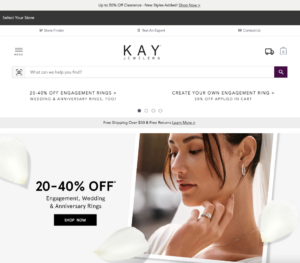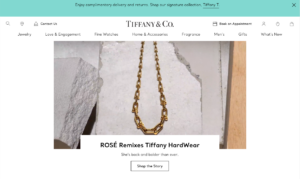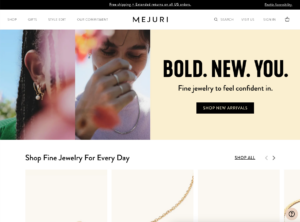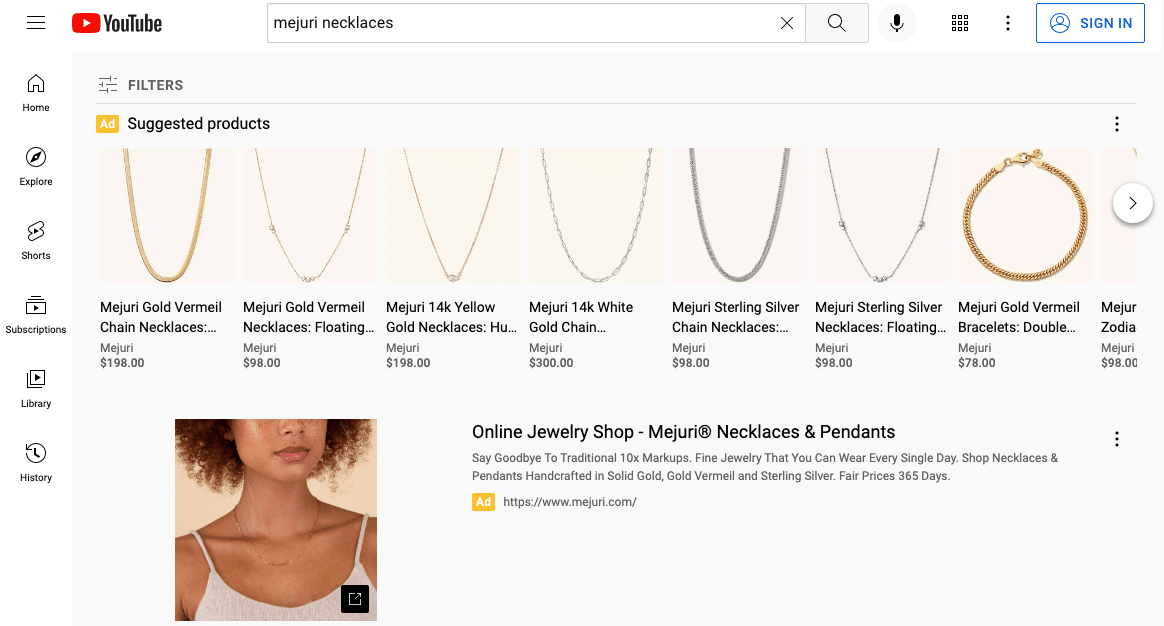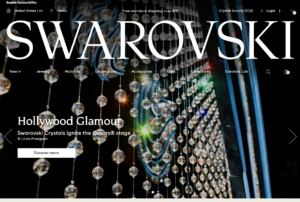Selling jewelry online is a challenging task.
There are many competitors trying to sell their own rings and necklaces, so you need to figure out how to bring your ideal customers to your website.
With Google Ads, you’re able to show ads in all of the different locations that Google has to offer.
The goal of this article is to discover the unique challenges that jewelry brands face when they’re running Google Ads, and how to be successful despite them!
Table of Contents
How Does Google Ads Work For Jewelry Brands?
Google Ads is a big platform, so if you use it for your jewelry business, you’ll be able to show ads in the following places:
- Google search results
- Shopping tab of the search results
- 3rd party websites
- YouTube
Each of these placements requires a different campaign type. But they all share the same underlying mechanic, you’re paying Google every time someone clicks on your advertisement.
How much you’re paying depends on where you want your ad to show, and who you want to reach.
Interesting Campaign Types for Jewelry brands
As I mentioned before, Google Ads is more complex than just a single ad format. There are many different campaign types that you can run. Let’s start with the most effective ones for your jewelry business.
Google Search Ads for Jewelry Brands
Google Search Ads, also commonly called text ads, are the most common ad format when people refer to Google Ads.
You select which keywords you want to advertise on, you tell Google how much you’re willing to pay for each click, and you put together a good advertisement.
Here is an example of what a text ad can look like for a jewelry business:
Search Ads can work pretty well because you’re able to reach people that are already looking for products similar to yours.
Within Search Ads, it’s important to make a distinction between branded keywords, these are people searching for your brand, and generic keywords.
The people that are searching for your brand already know (and likely) trust you, so the conversion rates will be a lot higher.
With other keywords, people might be looking for a category “rose gold necklaces”, or a particular product “18k hoop earrings”.
Since they’re not specifically looking for your brand or product, competition with other brands will be more intense, which means higher cost per click and lower conversion rates.
Google Shopping Ads for Jewelry Brands
Shopping Ads are the ads with a product image that you can find in the Google search results.
To start running these ads, you need to connect your online store to Google Merchant Center, a free tool by Google. Through this connection, you’re able to send all of your product data to Google, usually with a product feed.
Then Google Ads is able to process that information to create Shopping ads.
Here is what a Shopping Ad can look like for a jewelry business:
Unlike Search Ads, you’re not able to select which keywords you want your products to show up for. Google will use your product data to determine the best search queries to show these Shopping Ads for.
Your main job is to tell Google how much you’re willing to pay for each click.
This makes it a lot easier to get started, but also much harder to optimize your campaigns once they’re running.
Display Ads for Jewelry Brands
With Display ads, you’re able to show banner ads on websites that are opted into Google’s Display Network.
This is a HUGE collection of sites that ranges from sites like Reddit to Yahoo News or The Huffington Post.
First you need to create your display banners. To do this you have two options:
You can either provide a bunch of assets like images and text and let Google put the actual ad together.
Like this ad from Ritani:
It gets the job done, but frankyl is boring and doesn’t really tell me anything about the brand. If I’m honest it does the opposite: it’s boring and unappealing.
The second way to create a Display Ad is to create custom banners and upload them to Google. These looks a lot better, but it requires a lot more resources to put these together.
Here is a Display Ad from Blue Nile:
And one from George Jensen:
After you’ve created or uploaded your ads to Google Ads, you need to configure your campaign to decide to who you want to show these ads.
Google offers a number of different targeting options:
- Placements: you select the specific websites you want to show up for
- Topics or keywords: target different websites based on specific topics or keywords
- In-market or affinity audiences: these are groups of users that display certain behavior according to Google
- Demographics: age, gender, household income
- Remarketing audiences: these are people that have visited your website
- Customer Match: these are existing customers that you’ve identified in Google by uploading an email list
Reaching people that have been to your website usually is very effective. But reaching new audiences is a very hard challenge. To succeed you need a serious budget, design resource to create great visual assets and a very diligent testing program to find the best audience+ creative combos.
YouTube Ads for Jewelry Brands
The last campaign type is YouTube Ads.
There are a bunch of other campaigns that are also able to show ads on YouTube. That can be search, shopping and display ads.
But in this section, I want to talk about YouTube Ads, which are exclusively video ads.
From all campaign types, this is probably the hardest one to make work. That’s because having the right creative plays such a vital part in a campaign’s success. You can’t create one video and be done with it.
To be successful you need to test a lot of different videos and find the most effective audiences to show them to. It’s a tough nut to crack but can be very lucrative if you succeed.
So if you have created your videos, you need to upload them to YouTube.
Next, you can use these videos to set up a campaign through Google Ads by choosing one of the many targeting modes that Google offers for YouTube.
These are very similar to the targeting options I mention in the Display Ads section.
The most narrowest targeting option is when you choose to show your YouTube Ad on specific videos or channels, the broadest targeting option would be to show it to all women age 23-65.
Here is an example of such a brand from jewelry brand Pandora:
6 Unique Challenges That Jewelry Brands Face With Google Ads
By now, you should have a pretty good idea of what’s possible with Google Ads.
The goal of this section is to dive a bit deeper into the specific challenges that jewelry brands face when they’re trying to advertise on Google Ads.
Challenge #1 – High competition
Competition is very high in the online jewelry business, at every price point.
That’s because everyone’s competing for the same real estate. In the search results, you’ll find big luxury brands like Cartier competing with small up-and-coming jewelry designers.
This creates a challenging dynamic for smaller sellers.
More expensive products often mean a higher margin on every product that’s sold. This allows sellers of more expensive products to spend more on every click.
This can make it close to impossible for a seller selling a $45 necklace to compete with someone that’s selling a $250 one.
Challenge #2 – Wide range of price points
Someone looking for a necklace might have a $10 trinket in mind, or they might be looking for a $5,000 Bulgari gold necklace with diamonds.
This makes it important to have a good understanding of who you want to target.
With Search or Shopping Ads, potential customers indicate what they’re looking for through their search query.
Someone looking for an “18k gold necklace” is a lot more valuable compared to someone looking for a “necklace”.
In Google Shopping, it’s important to have product titles that accurately reflect your product attributes. If you’re using specific materials, it’s important to mention them, as this signals to Google who you want to reach.
While the ads in Search and Shopping Ads are very similar no matter the price point, Display or YouTube Ads give you more flexibility.
You not only have different targeting possibilities, but you also have more control over the look and feel of your advertisement. This allows you to reflect your brand in a better way.
Challenge #3 – Highly Seasonal
The jewelry business is highly seasonal.
Brands make the majority of their annual turnover during a couple of peak moments, Valentine’s Day, Mother’s Day, or the end of year sales.
These are the moments when people purchase jewelry. That means conversion rates are much higher which makes it easier to sell.
Unfortunately, other brands also know this. That means you’ll face more competitors, who are all willing to spend more money. This can drive up the cost per click by at least 25-100%.
The second challenge of a highly seasonal business is what happens outside of those peak times.
In the off-season, conversion rates will be lower, which usually means it will be harder to maintain a certain level of profitability (or high enough ROAS).
This makes it tricky from a Google Ads perspective. You’ll have to scale campaigns up or down depending on the season. Or you might have to pause campaigns in the down season because they are just impossible to make work.
Challenge #4 – Advertisements that are “on brand”
Most jewelry brands are very protective of what their brand looks like, and rightly so.
With Google Search or Shopping Ads, you’re pretty limited to be “on brand”:
- Headlines and description texts in your ads
- Copy of your product titles
- Product images
- Image extensions
- Uploading logo and business colors in Google Merchant Center
With Display or YouTube Ads, there is a lot more room to use your brand elements.
Challenge #5 – Lots of product variations
Offering a large number of products is great for customers.
If they are looking for a necklace, and you only have 1 option for them, the chances that you have what it takes are pretty slim.
But if you have different styles, colors, sizes, price points, and materials, they’re able to browse your catalog to find something they like.
When you’ve got something people are interested in, you’ll see this reflected in 2 metrics that you can track in Google Analytics. This first one is a lower bounce rate (= number of people that leave your website without visiting any other page) and the second one is a higher number of pages/sessions (= how many pages on your website do they visit).
Especially with Search ads, you often use category pages as landing pages. So having enough inventory is key to making that a good experience.
One important thing to get right on those pages are to have good product filters that allow visitors to drill down and discover the right product.
Challenge #6 – Hard to sample
Unlike a $100 pair of shoes from a known brand, jewelry is hard to sample through a website.
The quality offered by online jewelry sites varies wildly. Some products are amazing unique handcrafted pieces, while others are mass produced junk sold at insane markups.
It’s up to you to give visitors all the information that will enable them to make an informed decision.
Besides information, they also need to have a certain level of trust in your brand and website before they will purchase. And the higher the price point, the more important this is.
You can build trust through customer reviews, influencer endorsements, media publications, and being visible in multiple channels (like Facebook, PR and Google Ads).
Google Ads Alternatives For Jewelry Brands
If you’re running your own jewelry business, you’ll probably have realized that there are a ton of options to drive traffic to your store.
In fact, you might be a little overwhelmed at all the different things you can do.
That’s why I want to list the most common alternatives to Google Ads, and I’ll also mention how they’re different.
Facebook & Instagram Ads vs Google Ads
Both Instagram and Facebook are platforms that have the ability to drive a massive amount of traffic.
Since jewelry is a very visual product, it will usually perform well through image or video ads on the platform.
The main difference between Facebook Ads and Google Ads is that on Facebook, people aren’t really searching for your product. They are scrolling through their feeds, and your ads will interrupt what they are doing. And if you’re successful, they’ll click through to your site.
This is a very similar dynamic to what happens with Display or YouTube Ads.
This is a stark contrast to Search or Shopping Ads. With these ads you’re only targeting people that are actively searching for the products that you’re selling.
In the world of marketing this is called a higher purchase intent.
One is not better than the other, but they do require a very different approach!
SEO vs Google Ads
Search engine optimization (SEO) is the process of optimizing your website, so it ranks higher in the search results.
With Google Ads, you don’t need to optimize your site and can buy your way to the top of the page.
Increasing traffic through SEO usually is a long term game, it often takes 6 months or more to show any results.
Google Ads will get you clicks pretty instantly, but the major downside is that you have to pay for each click. And as soon as you stop paying, traffic also stops.
With SEO, you’re usually investing more up front, but once you’re ranking well, it’s essentially free.
Examples of Jewelry brands Using Google Ads
Pandora
Which Google Ads campaigns does Pandora use?
✅ Branded Search Ads
✅ Generic Search Ads
✅ Shopping Ads
✅ Display Ads
✅ YouTube Ads
Example of a Generic Search Ad from Pandora:
Kay
Which Google Ads campaigns does Kay use?
✅ Branded Search Ads
✅ Generic Search Ads
✅ Shopping Ads
✅ Display Ads
✅ YouTube Ads
Example of a Display Ad from Kay’s:
Tiffany
Which Google Ads campaigns does Tiffany use?
✅ Branded Search Ads
✅ Generic Search Ads
✅ Shopping Ads
✅ Display Ads
✅ YouTube Ads
Example of a YouTube Ad by Tiffany:
Mejuri
Which Google Ads campaigns does Mejuri use?
✅ Branded Search Ads
✅ Generic Search Ads
✅ Shopping Ads
❌ Display Ads
❌ YouTube Ads
Example of a Shopping Ad by Mejuri:
Swarovski
Which Google Ads campaigns does Swarovski use?
✅ Branded Search Ads
✅ Generic Search Ads
✅ Shopping Ads
✅ Display Ads
✅ YouTube Ads
Example of a YouTube Ad by Swarovski:

